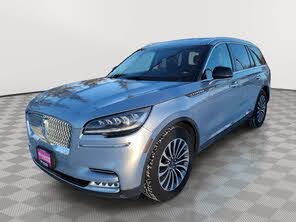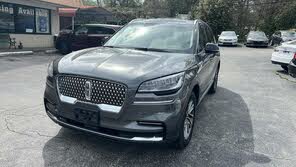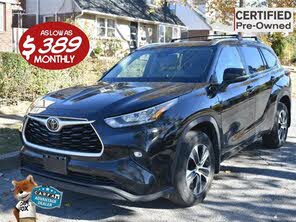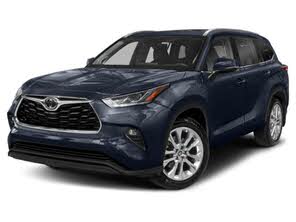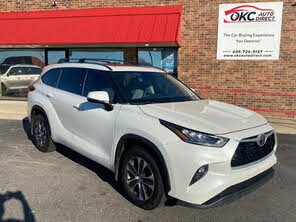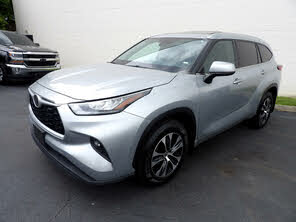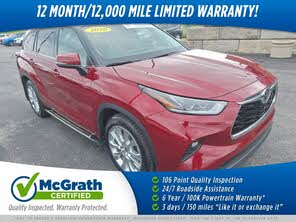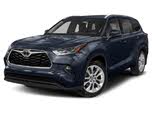2020 Lincoln Aviator vs 2020 Toyota Highlander
Overview | |
MSRP$51,100 | MSRP$34,600 |
Average price$35,862 | Average price$30,412 |
Listings546 | Listings539 |
Ratings & Reviews | |
User Reviews | User Reviews |
Expert reviews8.2 out of 10 | Expert reviews7.7 out of 10 |
Pros
| Pros
|
2020 Lincoln Aviator Reviews SummaryThe heyday for Lincoln was more than a half-century ago. Those postwar years of prosperity and optimism were the perfect time for cars like the Continental and others. They delivered comfort and luxury, wrapped in midcentury modern styling. Even as recently as the 1990s, Lincoln was still a popular brand, riding the SUV craze with its Navigator. But after the turn of the century, Lincoln lost its ability to create new designs and looked inward and backward. Sure, retro-themed cars like the redesigned Mustang, PT Cruiser, and Chevy HHR had turned some heads, but none of those came from luxury brands. The BMWs and Mercedes of the world were all looking forward and pushing the envelope for contemporary automotive design. Meanwhile, Lincoln offered the MKX, which was based on the Ford Edge and featured ’66 Continental styling. Neat in a vacuum, but off-base compared to the modern luxury market. This experimental phase with various retro looks coincided with the move to the MK-# alphabet-soup naming convention and big improvements in the Ford lineup, where top-end trims of the Fusion overlapped with an entry-level trim of the MKZ. The combination left Lincoln a confusing, anonymous afterthought in the modern luxury game. But Lincoln is finally ready to change all that. It has a new cohesive design language, its focus is once again on luxury, and the three-letter naming convention that never meant anything to anyone other than Lincoln marketers is gone. The brand led with the 2017 Continental and 2018 Navigator, which are each impressive in their own right. But the company's lineup is growing and now includes the all-new 2020 Lincoln Aviator. Named after a luxury variant of the 2002-2005 Ford Explorer, this new Aviator is also based on the contemporary Explorer platform, but it's a luxury vehicle in its own right. Much of the success of the Lincoln brand may hinge on this midsize, 3-row luxury SUV, so you need to consider its competition, such as the Audi Q7, Infiniti QX60, and all-new Cadillac XT6. Read on to learn if Lincoln’s take on luxury will stand out in a crowded competitive field. | |
2020 Toyota Highlander Reviews SummaryMidsize three-row SUVs are all spacious and powerful, but only the Toyota Highlander reaches the premium threshold for passenger comfort. Redesigned for 2020, the Highlander's revised styling and technology are secondary to its silent operation, soft ride, and cosseting interior. The upper trims feel and drive just like a Lexus, without the upcharge. There is nothing exciting about a Highlander, and yet, there is no other SUV in the $35,000 to $50,000 range that feels so effortless and tranquil. | |
Popular Features & Specs | |
Engine3.0L 400 hp V6 | Engine3.5L 295 hp V6 |
Drive TrainRWD | Drive TrainFWD |
Seating Capacity7 | Seating Capacity8 |
Horsepower | Horsepower295 hp @ 6600 rpm |
MPG City18 | MPG City20 |
MPG Highway26 | MPG Highway28 |
Engine | |
Engine Name3.0L 400 hp V6 | Engine Name3.5L 295 hp V6 |
Torque | Torque263 lb-ft @ 4700 rpm |
Horsepower | Horsepower295 hp @ 6600 rpm |
DrivetrainRWD | DrivetrainFWD |
Fuel Economy | |
MPG City18 | MPG City20 |
MPG Highway26 | MPG Highway28 |
Interior | |
Seating Capacity7 | Seating Capacity8 |
Safety | |
Front Crash Overall5 | Front Crash Overall4 |
Side Crash Overall5 | Side Crash Overall5 |
Dimensions & Capacity | |
Cargo Space18.3 cu ft | Cargo Space16.0 cu ft |
Curb Weight4764 lbs | Curb Weight4145 lbs |
Height69.8 in | Height68.1 in |
Length199.3 in | Length194.9 in |
Width89.9 in | Width76.0 in |
Wheelbase119.1 in | Wheelbase112.2 in |
Maximum Payload | Maximum Payload1685 lbs |
Number of doors4 | Number of doors4 |
Maximum Towing Capacity | Maximum Towing Capacity5000 lbs |
Overview | ||
MSRP | $51,100 | $34,600 |
Average price | $35,862 | $30,412 |
Listings | ||
Ratings & Reviews | ||
User reviews | ||
Expert reviews | 8.2 out of 10Read full review | 7.7 out of 10Read full review |
Pros & cons | Pros
| Pros
|
Summary | The heyday for Lincoln was more than a half-century ago. Those postwar years of prosperity and optimism were the perfect time for cars like the Continental and others. They delivered comfort and luxury, wrapped in midcentury modern styling. Even as recently as the 1990s, Lincoln was still a popular brand, riding the SUV craze with its Navigator. But after the turn of the century, Lincoln lost its ability to create new designs and looked inward and backward. Sure, retro-themed cars like the redesigned Mustang, PT Cruiser, and Chevy HHR had turned some heads, but none of those came from luxury brands. The BMWs and Mercedes of the world were all looking forward and pushing the envelope for contemporary automotive design. Meanwhile, Lincoln offered the MKX, which was based on the Ford Edge and featured ’66 Continental styling. Neat in a vacuum, but off-base compared to the modern luxury market. This experimental phase with various retro looks coincided with the move to the MK-# alphabet-soup naming convention and big improvements in the Ford lineup, where top-end trims of the Fusion overlapped with an entry-level trim of the MKZ. The combination left Lincoln a confusing, anonymous afterthought in the modern luxury game. But Lincoln is finally ready to change all that. It has a new cohesive design language, its focus is once again on luxury, and the three-letter naming convention that never meant anything to anyone other than Lincoln marketers is gone. The brand led with the 2017 Continental and 2018 Navigator, which are each impressive in their own right. But the company's lineup is growing and now includes the all-new 2020 Lincoln Aviator. Named after a luxury variant of the 2002-2005 Ford Explorer, this new Aviator is also based on the contemporary Explorer platform, but it's a luxury vehicle in its own right. Much of the success of the Lincoln brand may hinge on this midsize, 3-row luxury SUV, so you need to consider its competition, such as the Audi Q7, Infiniti QX60, and all-new Cadillac XT6. Read on to learn if Lincoln’s take on luxury will stand out in a crowded competitive field. | Midsize three-row SUVs are all spacious and powerful, but only the Toyota Highlander reaches the premium threshold for passenger comfort. Redesigned for 2020, the Highlander's revised styling and technology are secondary to its silent operation, soft ride, and cosseting interior. The upper trims feel and drive just like a Lexus, without the upcharge. There is nothing exciting about a Highlander, and yet, there is no other SUV in the $35,000 to $50,000 range that feels so effortless and tranquil. |
Video | ||
Popular Features & Specs | ||
Engine | 3.0L 400 hp V6 | 3.5L 295 hp V6 |
Drive Train | RWD | FWD |
Seating Capacity | 7 | 8 |
Horsepower | 295 hp @ 6600 rpm | |
MPG City | 18 | 20 |
MPG Highway | 26 | 28 |
Engine | ||
Engine Name | 3.0L 400 hp V6 | 3.5L 295 hp V6 |
Torque | 263 lb-ft @ 4700 rpm | |
Horsepower | 295 hp @ 6600 rpm | |
Drivetrain | RWD | FWD |
Fuel Economy | ||
MPG City | 18 | 20 |
MPG Highway | 26 | 28 |
Interior | ||
Seating Capacity | 7 | 8 |
Safety | ||
Front Crash Overall | 5 | 4 |
Side Crash Overall | 5 | 5 |
Dimensions & Capacity | ||
Cargo Space | 18.3 cu ft | 16.0 cu ft |
Curb Weight | 4764 lbs | 4145 lbs |
Height | 69.8 in | 68.1 in |
Length | 199.3 in | 194.9 in |
Width | 89.9 in | 76.0 in |
Wheelbase | 119.1 in | 112.2 in |
Maximum Payload | 1685 lbs | |
Number of doors | 4 | 4 |
Maximum Towing Capacity | 5000 lbs | |
The 2020 Lincoln Aviator was positioned between the larger Navigator and the smaller MKC and Corsair in Lincoln's lineup. It marked a return to real vehicle names, moving away from the previous alphabet-soup naming convention. The Aviator featured a unified design language across Lincoln's range, with elegant headlights and a prominent chrome grille. Its tapered roofline and low, wide beltline gave it a sleek, boat-like appearance. Inside, the Aviator boasted a luxurious cabin with soft-touch materials and a flowing design. The seats were both elegant and sturdy, with a piano-key design for the shifter buttons. The Aviator's interior was plush, with leather used generously throughout, even in areas where it wasn't necessary, showcasing Lincoln's commitment to luxury. Unique touches like a panoramic moonroof and orchestral warning jingles added to its appeal.
The 2020 Toyota Highlander, from the side, could blend in with many other vehicles. It featured a trapezoidal theme in its design, with slanted tailgate glass and exaggerated body panel creases. The Highlander had LED headlights and fog lights on all trims except the base L, with the Limited and Platinum trims boasting LED running lamps and 20-inch wheels. The interior was where the Highlander shone, with quality fit and finish. Silver-painted accents and a multi-layered dash added to its appeal. The Limited trim offered a three-tone interior with padded surfaces and rich textures. The Highlander's interior was compared favorably to competitors like the Ford Explorer and Honda Pilot, with only the Kia Telluride matching its quality. The exterior styling, however, was considered less inviting than the interior.
The 2020 Lincoln Aviator came standard with a twin-turbocharged 3.0-liter V6 engine, producing 400 horsepower and 415 pound-feet of torque. The Grand Touring model combined this engine with a 100-hp electric motor, resulting in a total output of 494 hp and 630 lb-ft of torque. Both powertrains used a 10-speed automatic transmission, with the base V6 offering rear-wheel drive or all-wheel drive, while the plug-in hybrid was all-wheel drive only. The Aviator could accelerate from 0-60 mph in about 4 seconds, regardless of the powertrain. The Grand Touring's hybrid setup provided smooth acceleration and improved fuel efficiency, with a combined 23 mpg and a 21-mile electric-only range. The Aviator's steering was light, and its brakes were effective but cushioned. It offered an "Excite" drive mode for a more dynamic experience, though its 5,600-pound weight limited its agility. Fuel economy for the conventional Aviator was 18 mpg city, 26 highway, and 21 combined for RWD, and slightly lower for AWD.
The 2020 Toyota Highlander featured a 3.5-liter V6 engine, available in front-wheel drive or all-wheel drive. This engine, shared with the Lexus RX, delivered 295 horsepower and 263 pound-feet of torque, providing smooth and quiet acceleration. The eight-speed automatic transmission made full use of the engine's power, though it required a heavy foot for quick acceleration. The Highlander's steering was loose, and its suspension was soft, leading to a floating sensation at speed. Despite being on a new, stiffer chassis, the Highlander lacked the control expected from Toyota. However, it offered a comfortable and isolating driving experience, ideal for long road trips. The Limited and Platinum trims included torque vectoring for AWD models and selectable driving modes. Fuel economy was impressive, with the FWD model achieving 21 mpg city, 29 highway, and 24 combined, while the AWD model was slightly lower. The Highlander hybrid, reviewed separately, offered up to 36 mpg combined.
The 2020 Lincoln Aviator, with its three rows, competed with models like the Audi Q7 and Mercedes-Benz GLE. The optional second-row captain's chairs were highly praised, while the power-closing third row was adequate for adults but better suited for children on longer trips. With the second and third rows folded, the Aviator offered 77 cubic feet of cargo space, comparable to the Cadillac XT6. The Aviator's interior featured some unconventional controls, such as the door handles and seat adjustments, which could be confusing. The 30-way seats included a massage function, but their controls were complex. The door-release function was also non-traditional, requiring some getting used to.
The 2020 Toyota Highlander could seat eight or seven with second-row captain's chairs, standard on Limited and Platinum trims. The second-row seats were versatile, with generous adjustments and easy access to the third row. The Highlander offered exceptional ingress and egress, with wide-opening rear doors and comfortable seat heights. It featured three-zone climate control, with upper trims offering additional amenities like a 120-volt outlet and heated second-row seats. Cargo space was generous, with 16 cubic feet behind the third row, 48 cubic feet behind the second, and 84 cubic feet with both folded. The Highlander included eight cupholders, four bottle holders, and two shelves integrated into the dash. Controls were simple and legible, with an easy-to-use infotainment interface.
The 2020 Lincoln Aviator came with the Sync 3 infotainment system, featuring a 10.1-inch touchscreen in a landscape layout. This setup allowed for full-screen Apple CarPlay and Android Auto integration, providing large icons and readouts. The Aviator also had a fully digital instrument panel and a large head-up display, offering a wealth of information in a minimalist format.
The 2020 Toyota Highlander's infotainment system felt outdated, with low-resolution maps and screens. The 12.3-inch touchscreen, optional on Limited and standard on Platinum, couldn't fully display maps or vehicle options, as climate and fuel economy info were always present. Apple CarPlay, Android Auto, and Amazon Alexa integration were standard. The Highlander featured a 10-inch head-up display and a 7-inch display in the instrument cluster, both crisp and informative. The semi-automated driving system was effective, with adaptive cruise control and road sign detection. The optional JBL audio system was decent, and the Highlander included standard features like SiriusXM, HD radio, WiFi, and USB ports.
The 2020 Lincoln Aviator included standard safety features such as front and side-impact airbags, traction control, and a tire pressure monitoring system. It also came with Lincoln Co-Pilot360, a suite of driver-assistance systems that included forward-collision avoidance, lane-departure warning, adaptive cruise control, and automatic high beams. Additional safety tech included blind-spot monitoring and a head-up display.
The 2020 Toyota Highlander featured Toyota Safety Sense 2.0 as standard, which included automatic emergency braking with pedestrian and cyclist detection, lane-keeping assist, adaptive cruise control, and automatic high beams. Optional features included blind-spot monitoring, parking sensors, and rear emergency braking. The Highlander had a driver's knee airbag and a cushion airbag for the front passenger. The IIHS awarded it a 2020 Top Safety Pick for its top ratings in crash tests and emergency braking performance.
CarGurus highlights

According to CarGurus experts, the overall rating for the 2020 Lincoln Aviator is 8.2 out of 10, while the 2020 Toyota Highlander scores 7.7 out of 10. Based on these ratings, the Lincoln Aviator is the recommended choice for those seeking a more luxurious and technologically advanced SUV.
Choose the 2020 Lincoln Aviator if:
- You prioritize a luxurious interior with high-quality materials and unique features like orchestral warning jingles.
- You want a powerful engine with a plug-in hybrid option for enhanced performance and fuel efficiency.
- You appreciate advanced technology with a user-friendly infotainment system and a large head-up display.
Choose the 2020 Toyota Highlander if:
- You need a versatile and spacious interior with ample cargo space and comfortable seating for up to eight passengers.
- You value a smooth and quiet driving experience with good fuel economy for a large SUV.
- You prefer a comprehensive suite of standard safety features and a high safety rating from the IIHS.
CarGurus highlights

According to CarGurus experts, the overall rating for the 2020 Lincoln Aviator is 8.2 out of 10, while the 2020 Toyota Highlander scores 7.7 out of 10. Based on these ratings, the Lincoln Aviator is the recommended choice for those seeking a more luxurious and technologically advanced SUV.
Choose the 2020 Lincoln Aviator if:
Shop Now- You prioritize a luxurious interior with high-quality materials and unique features like orchestral warning jingles.
- You want a powerful engine with a plug-in hybrid option for enhanced performance and fuel efficiency.
- You appreciate advanced technology with a user-friendly infotainment system and a large head-up display.
Choose the 2020 Toyota Highlander if:
Shop Now- You need a versatile and spacious interior with ample cargo space and comfortable seating for up to eight passengers.
- You value a smooth and quiet driving experience with good fuel economy for a large SUV.
- You prefer a comprehensive suite of standard safety features and a high safety rating from the IIHS.

By: CarGurus + AI
At CarGurus, our team of experienced automotive writers remain at the heart of our content operation, conducting hands-on car tests and writing insightful guides that are backed by years of industry experience. To complement this, we are harnessing AI to make our content offering more diverse and more helpful to shoppers than ever. To achieve this, our AI systems are based exclusively on CarGurus content, ratings and data, so that what we produce is both unique to CarGurus, and uniquely helpful to car shoppers.













